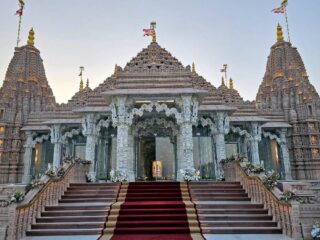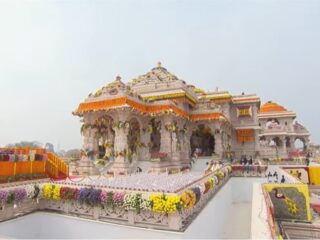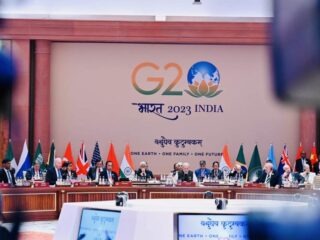Asghar Ali Engineer
(Secular Perspective December 16-31, 2010)
Akbar Ahmad who teaches in American University, Washington D.C. and holds Ibn Khalladun Chair of Islamic Studies and is author of several well known books has come out with field study of American Muslims. This book will go a long way to break many myths about Islam, Muslims and America.[1] This book is based on field interviews with Muslims living in America in different states. Prof. Ahmed traveled with his team across America and talked to Muslim leaders in every state.
This is an important academic work based on field study and hence its importance cannot be denied. Prof. Ahmed himself is a trained anthropologist and he knows how communities and ideological groups should be studied to know them and their behaviour. From outside even western academics think that Muslims are a homogenous lot and all, irrespective of their ethnic, tribal or national origin hold same religious as well as political views. Such an unrealistic approach becomes main obstacle in understanding Muslims and multiple interpretations of Islam.
If this is an approach of academics what to say of lay persons. If they hold similar views we cannot blame them. It is field study like this which can convince people that Muslims are far from being a homogenous lot. Despite slogans like umma wahidah Muslims have differed both religiously and politically from each other since the death of the Prophet (PBUH). Even within the confines of Arabia where Islam originated, Muslims could not become umma wahidah how could they after Islam spread in far off places like China, India, Central Asia, Far East and Europe with radically different civilizations, languages, tribes and ethnicity?
Yes, ideologically the slogan of umma wahidah is quite meaningful but ideology and reality greatly differ from each other. Ideology after all represents certain ideals and values and reality is far more complex in which human actors bring to bear their interests, political, economic, cultural or linguistic and many others. It is because of this that Muslims could never become homogenous community. This has been very well brought out in this book on American Muslims.
America is a unique country in many ways. It is also unique as peoples of various nations and countries have come there for various reasons, either to improve their economic lot or for refuge from persecution back home. Thus there is hardly any country in the world with Muslim population whose citizens have not migrated to America. Thus in America one finds much greater diversity of Muslims than any other country in the world. It is, I say and especially after reading this book that Muslim diversity in America is indeed bewildering.
Thus it would be wrong to hold that All Muslims in America hold same views about terrorism or for that matter about various interpretation of Islam. Whatever trends in Islamic thinking from Sufi to Wahabi to tablighi to ahl-e-hadith to Shi’ah to Ismaili to Bohras to Sunni are present in America which come out clearly in various interviews. Muslims from all these sects have flocked to America for better living.
This migration from Asian and African countries to America has created what can be called schizophrenic nationalism or dual nationalism. One who migrates retains ties with his/her own national cultural roots and also has to develop or assimilate American culture. The first generation finds it very difficult to do so though succeeding generation ultimately looses attachment to the culture of the country of origin. But it takes quite a struggle do so. This tension between two generations of Muslims also comes out clearly in the interviews.
The question of American identity is also very important and the author throws light on this question in the very first chapter of the book. Identity plays very important role in one’s life as it is deeply psychological and emotional in nature. Identity is very complex issue and its constituents are language, culture, ethnicity, customs and traditions. It is very difficult to shade and acquire a new identity. It was easier for the very first generation of Europeans to do so as all of them were Europeans, protestant Christians though from different linguistic and cultural backgrounds. But the fact that they were all Europeans and mostly Protestants they found it easy to adopt what has been called melting pot model of identity.
Their original identity melted and a new American identity emerged. But it was not so easy for subsequent generations of migrants from African and Asian countries. They were not Christians (at least not all), they were not Europeans and this made all the difference. They had very distinctive skin color and radically different culture. It was not so easy for them to melt their original identity and adopt new American identity. So a different model of identity had to be evolved and now their original identity is retained and they are called African Americans or Indian or Pakistani or Chinese or Korean Americans and so on. It is in a way more realistic and democratic.
Thus it would be not sufficient to call a Muslim living in America as American Muslim; it may even be misleading in a way. So they are referred to now as Egyptian-American or Saudi-American or Iranian-American and so on. Of course in these countries people of other religions like Christians, Zoroastrians and others also live but they are generally small minorities. So an Egyptian-American would generally mean Egyptian Muslim or Saudi Muslim living in America. Thus the business of identity has to be taken pretty seriously.
The part I of the book deals with question of American identity while part II deals with “Islam in America” and Ahmed devotes fourth chapter in this second part to African Americans as first Muslims. The African Americans of course have been living in America for several centuries and have forgotten their African roots also. It is for this reason that when an African American did great deal of research to trace his African roots and wrote a book it sold like hot cakes. Even after centuries African Americans want to know their roots. Such is the hold of identity on human beings. Just imagine the plight of recent migrants who retain strong ties with their country of migration.
The Part III of the book deals with adjusting and adapting. There are three chapters under this part i.e. Jews and Muslims: Bridging a Great Divide, Mormons and Muslims: Getting to Know You and The Importance of Being American.
The author and his research team meets with different communities of Muslims and their leaders and also imams of the mosques. Most of the meetings take place in mosques or in restaurants on lunch or dinner. For example sample this: Imam Fateen Seifullah heads the Masjid As-Sabur, the oldest mosque in Las Vegas (what author calls ‘sin city’ as this city is city of gambling dens) and a haven for celebrities like Muhammad Ali and Mike Tyson – the latter, we were told, helps to vacuum the mosque’s prayer rugs as an act of piety.
Imam Fateen has an easygoing charm and radiates energy in his dedication to changing society around him. Islam provides him the perfect platform. Like Imam Mustafa, he seemed a thoughtful man living in the desert for spiritual answers. Akbar narrates an interesting story about Fateen. When he went to Morocco with some other African American Muslims he visited a sheikh. He was wearing Muslim clothes. The Sheikh inquired where are Americans. Right here, Fateen answered. Upon this the Sheikh inquired why are you then wearing Moroccan clothes, bring your uniqueness as Americans on the table. Be American.
Akbar Ahmed travels across America and visits small Muslim communities like Vietnamese Muslims, Cambodian Muslims, Chinese Muslims apart from Muslims from countries like Indonesia, Malaysia, Thailand, India, Pakistan, and various Arab countries as well as African countries. It is very clearly brought out differences in thinking and approaches of these Muslims from different countries. Even their concerns are so different. It breaks once for all the myth that all Muslims in America are admirers of Osama bin Laden or support al-Qaeda.
The younger generations of Muslims from these countries have been greatly Americanized and that is the real worry of Muslims belonging to older generations. They feel their language and culture would be lost for ever and want these younger people to retain those elements. Also, it also comes out clearly through this first important study of American Muslims that white Americans are, after all, not that liberal and secular we imagine them to be. Most of the interviews bring out the kind of discrimination they feel and despite the fact that they have assimilated themselves in American way of life. There are often violent attacks and some young Muslims have formed their own gangs to retaliate.
This book is an important landmark in serious field study of American Muslims and though by a leading academic and yet written in a manner which can be easily understood by lay people having no anthropological background The academic jargon has been avoided.
—————————————————–
Centre for Study of Society and Secularism
Mumbai.
[1] – Akbar Ahmed Journey into America – The Challenge of Islam (Brookings Institution Press, Washington D.C.2010), PP-528,




